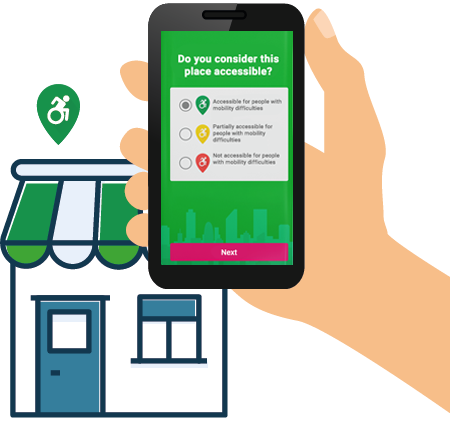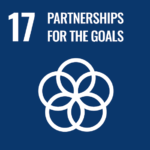Accessibility and Inclusion in companies and buildings.
Why Wheelguide Certification?
The promotion of inclusion stands out among good ESG (Environmental, Social and Governance) practices and the UN Sustainable Development Goals. It is, in fact, fundamental and has a strong component in accessibility.
The Wheelguide Certification is a program that enhances and recognizes the best accessibility and inclusion practices. The following are eligible for certification: commercial buildings, offices, logistics warehouses, shopping malls, schools and others, whether existing buildings or in the project phase.
Wheelguide Certification is the first program that:
Do you want to have your establishment Certified?
How does the Wheelguide Certification work?

CERTIFICATION PILARS
The Wheelguide Certification process takes place on 4 fundamental pilars:
Environment

Employees/
Support

Governance

Community


Environment

TECHNICAL EVALUATION
If the site is in the design phase, the assessment takes place in two stages: in design and in loco.
If the site is already built, the assessment takes place in a single step: in loco.
FOLLOW-UP AND TECHNICAL SUPPORT
The Wheelguide team, through consultations and guidance, offers technical support for all issues related to accessibility. The manager of the site in the certification process can access the dashboard and check the performance of his activities and goals.

Employees/Support

With the aim of training people to improve everyone’s experience, employees are invited to participate in the “Accessible Attitude Wheelguide Training”.
The following topics are addressed:
➜ Concept of Accessibility
➜ Terms to refer to Persons with Disabilities
➜ Principles for an Accessible Attitude
➜ Characteristics of people with disabilities: physical, visual, auditory and intellectual
➜ Temporary conditions of reduced mobility
➜ Improving Accessibility through Digital Volunteering
➜ Qualitative research on the workplace

Governance

To enhance the engagement of the organizations, a Wheelguide meeting is held with the leadership. On this occasion, participants are informed about the performance of the company/condominium in the Wheelguide Certification process and the issue of accessibility is addressed as a strategic differential for business.

Community

To continuously improve accessibility, it is necessary to place the user of the space, whether a person with a disability or not, as the protagonist of the process.
Thus, once the work is carried out internally, the location is encouraged to encourage its employees, to assess the accessibility of its spaces, surrounding establishments and anywhere in the world in the Wheelguide app.
This action also aims to make people aware of the importance of accessibility for all.

Impacts and Results
After 12 months, an impact report is delivered with the results and the description of good accessibility and inclusion practices carried out by the location.
This document makes reference to the GRI Standards to communicate the ESG impacts of organizations, presents performance indicators and proposes goals for the continuous improvement of the next fiscal year.
By meeting the goals for Wheelguide Certification, the site works on the following Sustainable Development Goals (UN):

Ensure inclusive and equitable quality education and promote lifelong learning opportunities for all

Promote sustained, inclusive and sustainable economic growth, full and productive employment and decent work for all

Reduce inequality within and among countries

Make cities and human settlements inclusive, safe, resilient and sustainable

Ensure sustainable consumption and production patterns

Promote peaceful and inclusive societies for sustainable development, provide access to justice for all and build effective, accountable and inclusive institutions at all levels

Strengthen the means of implementation and revitalize the Global Partnership for Sustainable Development

Wheelguide Certification
If the criteria are met on all axles, the site achieves Wheelguide Certification.
As they are committed to improving the experience, companies/enterprises that participate in the certification process receive special attention in the Wheelguide App, on the wheel.guide Portal, and are part of the annual Impact Report and other publications.
Do you want to have your establishment Certified?
Wheelguide Cases Certification
See some companies and ventures that have won the Wheelguide CertificationSanofi
In Certification
2022
Pepsico
In Certification
2022
Sanofi
Certificate
2022
Sanofi
In Certification
2021
Mercado Livre
Certificate
2020
Netflix
In Certification
2021
WHEN AN IDEA IS GOOD, IT IS GOOD FOR EVERYONE
The Wheelguide Certification is a program that enhances and recognizes the best accessibility and inclusion practices.
Commercial buildings, offices, logistics warehouses, shopping malls, schools and others are eligible for Guiadero Certification, whether existing buildings or those in the design phase.
The original methodology of the Wheelguide Certification was jointly developed by an interdisciplinary team, made up of specialist architects, researchers and people with disabilities. It is based on the premise that accessibility should be seen as an ongoing exercise and on the concept that “accessible environments” are composed of physical structure and people.
As a result, the assessment goes beyond compliance with current legislation and technical standards drawn up by regulatory bodies. By understanding accessibility as a living organism and incorporating human factors, the evaluation process also takes into account the practical experience of people with disabilities, the perception of regular users of the space, hospitality and aspects of interpersonal treatment.
Valuation of the property, reduction of regulatory risks, safety and prioritization of the health and well-being of occupants, user satisfaction, awareness and engagement in the cause, positive social impact, etc.
The certification process takes place fundamentally in 4 pilars:
1- Environments
In this pilars, the technical evaluation of the space takes place (in design and in loco) and solutions are presented to overcome architectural obstacles. Constant technical support is also offered for follow-up and any doubts.
2- Employees/Support
In this pilars, company/enterprise employees have access to Guiaderodas Attitude Acessível Training. Through concepts and experiences, participants are able to proactively deal with people with disabilities or mobility restrictions.
3- Governance
In this pilars, there is a conversation with the company’s leadership to raise awareness and commitment to the cause.
4- Community
In this pilars, the location is encouraged to encourage its employees, to assess the accessibility of its spaces, surrounding establishments and anywhere in the world in the Guiaderodas app.
Environments – Critical barriers must be resolved.
Employees/Support – In undertakings, all collaborators in the operation must be trained. In companies, at least 30% of employees must be trained.
Governance – Leadership commitment to continuous improvement through declarations, dedicated committees and involvement of leaders in training.
Community – Carrying out a campaign that encourages digital volunteering and assessing the accessibility of places on the Guiaderodas platform.
In addition to personal contact with the Guiaderodas team, the site manager has access to the client’s area, being able, through a dedicated dashboard, to follow the update of activities and the company’s performance in each of the axes.
The cost varies according to the total area, complexity and number of employees.
The certification implementation process lasts 12 months.
The certification implementation process lasts 12 months.
Yes. The check takes place through an on-site visit or by sending photographic evidence.
Being accessible and inclusive is a daily exercise that requires great commitment from corporations.
As important as the achievement of the Certification is its maintenance. Environments are dynamic, understandings are improved and operating teams are reformulated.
Therefore, once certified, the location must maintain the current certification on an ongoing basis, establishing a commitment to continuous improvement and taking solid steps in that direction.




